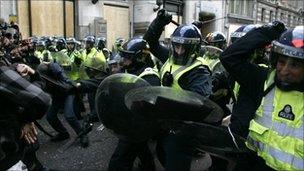London G20 demo: Met police 'kettling' criticised
- Published

Protesters challenged the Met's containment tactics
The legality of police using riot shields to land blows on protesters at the G20 demonstrations has been called into question at the High Court.
Demonstrators are seeking a judicial review into the policing of the protests in the City of London.
Chris Abbott, Hannah McClure and Josh Moos are challenging the Metropolitan Police's containment strategy.
They claim the force's use of "shield strikes" as part of their "kettling" tactics in April 2009 was unlawful.
Michael Fordham QC, appearing for the protesters, argued so-called shield strikes were "not a recognised form of reasonable force at all", or an approved police defensive technique found in police manuals.
Chief Supt Michael Johnson, of the Met's Territorial Support Group, who was in command during the G20 demonstrations, defended his decision to use kettling tactics, saying that protesters had been involved in serious disturbances throughout the day.
'Totally inappropriate'
He told the court that a Camp for Climate Action outside the Carbon Exchange in Bishopsgate was relatively peaceful and there was no reason for the police to think that violence was imminent there.
Mr Fordham said the police had acted because of the separate G20 protest taking place nearby in the City, outside the Royal Exchange, where there had been violence.
The kettle was imposed at 1900 BST as the police carried out a controlled dispersal of the Royal Exchange demonstrators and did not want any "mixing" of the two sets of protesters.
Mr Fordham argued that, even if it was necessary to keep the two groups apart, "advancing towards the climate camp in riot gear, wielding batons and using shields offensively was a totally inappropriate response".
The extensive use of shield strikes by the police throughout the containment operation was "particularly objectionable", he said.
Police officers had described in their notebooks using shield strikes "both flat and angled" and using the shield edge.
Bottles thrown
The tactics were apparently deployed on the instructions of senior officers.
Chief Supt Johnson said: "The Royal Exchange protesters had been involved in serious disturbances throughout the day.
"I was concerned to keep them from mixing with the demonstrators at the climate camp, which had during the day become increasingly volatile."
It was that increasing volatility which had led him to decide that there could be a breach of the peace at the camp and led him to impose the kettle, Chief Supt Johnson said.
He said there had been incidents, including the throwing of bottles and coins at the police lines and the damaging of police carriers.
"People in the climate camp had been engaged in disorder throughout the day," he said.
'Reasonable' force
Shield strikes formed no part of the tactics set out in the 2004 Acpo Public Order Standards, Tactics and Training Manual, Mr Fordham argued.
Neither were they an approved police defensive technique explained in the Met's Officer Safety Manual.
Responding to the criticism of shield strikes, Chief Supt Johnson said in written submissions the fact that they had not been described in the manuals did not make them illegal.
If an officer was deployed with a shield, could use it to the extent "that use of force is reasonable and proportionate", he said.
The Public Order Officers Safety Manual, a new Met guide, did cover shield techniques, and the tactical use of shields was covered by the Public Order Trainers Manual.
The hearing is expected to last three days.
- Published24 February 2011
- Published25 January 2011
- Published19 January 2011
- Published6 January 2011
- Published9 December 2010